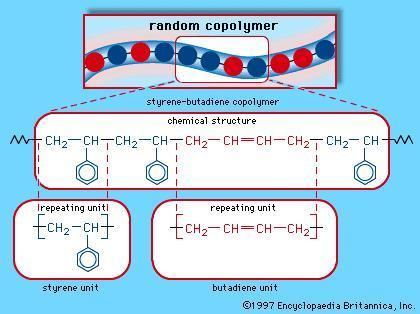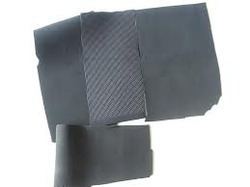 | ||
Styrene-butadiene or styrene-butadiene rubber (SBR) describe families of synthetic rubbers derived from styrene and butadiene (the version developed by Goodyear is called Neolite). These materials have good abrasion resistance and good aging stability when protected by additives. In 2012, more than 5.4 million tonnes of SBR were processed worldwide. About 50% of car tires are made from various types of SBR. The styrene/butadiene ratio influences the properties of the polymer: with high styrene content, the rubbers are harder and less rubbery. SBR is not to be confused with a thermoplastic elastomer made from the same monomers, styrene-butadiene block copolymer.
Contents
- Styrene butadiene
- Types of SBR
- Emulsion polymerization
- Solution polymerization
- Buna S
- Applications
- History
- References

Styrene butadiene
Types of SBR

SBR is derived from two monomers, styrene and butadiene. The mixture of these two monomers is polymerized by two processes: from solution (S-SBR) or as an emulsion (E-SBR). E-SBR is more widely used.
Emulsion polymerization
E-SBR produced by emulsion polymerization is initiated by free radicals. Reaction vessels are typically charged with the two monomers, a free radical generator, and a chain transfer agent such as an alkyl mercaptan. Radical initiators include potassium persulfate and hydroperoxides in combination with ferrous salts. Emulsifying agents include various soaps. By "capping" the growing organic radicals, mercaptans (e.g. dodecylthiol), control the molecular weight, and hence the viscosity, of the product. Typically, polymerizations are allowed to proceed only to ca. 70%, a method called "short stopping". In this way, various additives can be removed from the polymer.
Solution polymerization

Solution-SBR is produced by an anionic polymerization process. Polymerization is initiated by alkyl lithium compounds. Water is strictly excluded. The process is homogeneous (all components are dissolved), which provides greater control over the process, allowing tailoring of the polymer. The organolithium compound adds to one of the monomers , generating a carbanion that then adds to another monomer, and so on. Relative to E-SBR, S-SBR is increasingly favored because it offers improved wet grip and rolling resistance, which translate to greater safety and better fuel economy, respectively.
Buna S

The material was initially marketed with the brand name Buna S. Its name derives Bu for butadiene and Na for sodium (natrium in several languages including Latin, German, and Dutch), and S for styrene.
Applications

It is a commodity material which competes with natural rubber. The elastomer is used widely in pneumatic tires. This application mainly calls for E-SBR, although S-SBR is growing in popularity. Other uses include shoe heels and soles, gaskets, and even chewing gum.
Latex (emulsion) SBR is extensively used in coated papers, being one of the cheapest resins to bind pigmented coatings.
It is also used in building applications, as a sealing and binding agent behind renders as an alternative to PVA, but is more expensive. In the latter application, it offers better durability, reduced shrinkage and increased flexibility, as well as being resistant to emulsification in damp conditions.
SBR is often used as part of cement based substructural (basement)waterproofing systems where as a liquid it is mixed with water to form the Gauging solution for mixing the powdered Tanking material to a slurry. SBR aids the bond strength, reduces the potential for shrinkage and adds an element of flexibility.
It is also used by speaker driver manufacturers as the material for Low Damping Rubber Surrounds.
Additionally, it is used in some rubber cutting boards.
SBR is also used as a binder in lithium-ion battery electrodes, in combination with carboxymethyl cellulose as a water-based alternative for, e.g. polyvinylidene fluoride.
History
SBR is a replacement for natural rubber. It was originally developed prior to World War II in Germany by chemist Walter Bock. Industrial manufacture began during World War 2, and was used extensively by the U.S. Synthetic Rubber Program to produce Government Rubber-Styrene (GR-S); to replace the Southeast Asian supply of natural rubber which, under Japanese occupation, was unavailable to Allied nations.
